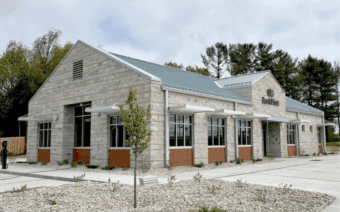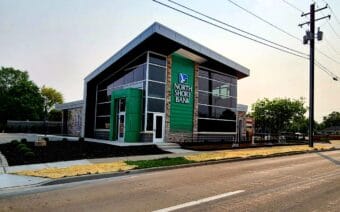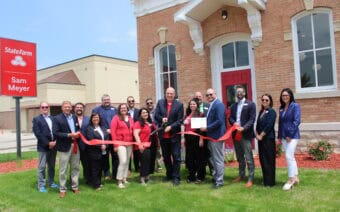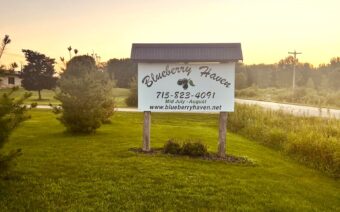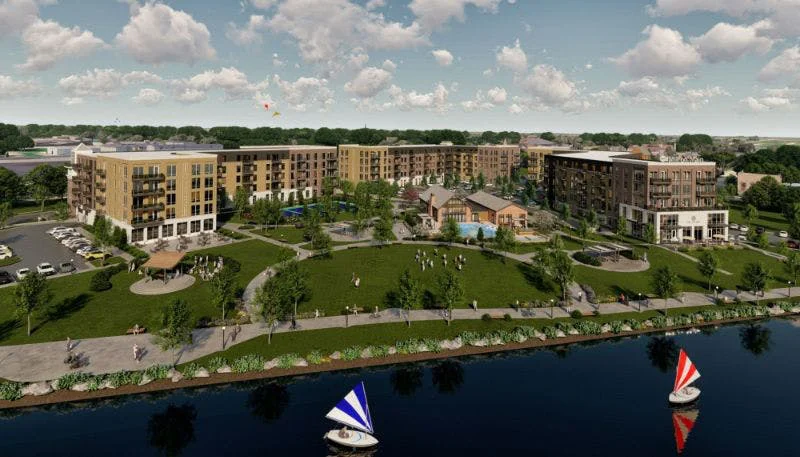
September 12, 2022
OSHKOSH – If you’ve visited Oshkosh lately, you might have noticed the boom of new apartment complexes being built, especially on or near the Fox River.
Many would consider it a good place for residential development.
Madison-area developer T. Wall Enterprises, who will construct a three-building, mixed-use development on East 7th Avenue, builds all its properties near water or parks – Oshkosh has an abundance of both.
T. Wall recently received the green light from the City of Oshkosh to construct the complex on the south side of the Fox River between South Main Street and the railroad tracks near Pioneer Drive.
In order to make the development happen in this blighted area – which was previously mostly all industrial – the city has created Tax Incremental Financing District No. 43.
Tax incremental financing (TIF) is a financial tool used by local governments to fund economic development.
It allows governments to finance development projects with the revenue generated by the development.
Known as Mill on Main – with an official address of 43 E. 7th Ave. – T. Wall officials said they plan to build a mixed-use development with multifamily and commercial uses that will take advantage of South Main Street’s high visibility.
That will complement the Fox River and its future Riverwalk, as well as the Lake Winnebago area.
Plans include approximately 291 luxury apartments; 19,000 commercial square feet; 240-255 underground parking stalls; and 194 surface parking stalls.
The three, five-story buildings would be constructed on the 13.45 acres, one building at a time, with the first two phases including approximately 10,000 square-feet of commercial space in each building – one which will be a restaurant with water views of the Fox River and Lake Winnebago.
The city projects that approximately $47.8 million in improved value will result from the development T. Wall will be creating.
“Because the TID is a 27-year TID, the additional value the development is creating will be added to the tax roll after the entire TID is closed,” Kelly Nieforth, director of community development for the City of Oshkosh, said.
?

Officials said the project known as Mill on Main will be mixed-use development with multi-family and commercial uses. JLA Architects Illustration.
Meanwhile, it’s expected the City will spend just under $29 million for project plan costs.
The plans include an estimated $20.07 million in “pay as you go” development incentives (principal and interest), an estimated $210,000 in administrative costs and an estimated $8.7 million in contingent expenditures – including underground utilities, environmental remediation, a trailhead parking lot, improvements along South Main Street, public docks and a land write-down.
“We view this project as a catalyst project in our Sawdust District,” Nieforth said. “We hope the investment T. Wall is making – about $90 million – will spur other development in the area along South Main Street and hopefully even over in the Pioneer Island and marina area.”
Nieforth said she hopes with more people (eventually) living in the Sawdust District, there will be more commercial development.
“Our hope is the commercial development will also move into some of the existing buildings – some of which are historical in nature,” she said. “We’re also hoping that other development occuring in the Sawdust District won’t need any TIF money so that improved value can go on the tax roll sooner.”
Jake Bunz, development analyst with T. Wall Enterprises, said they already had projects in Green Bay and Neenah, so they had already been looking in the Fox Valley region.
“Oshkosh is one of the main cities in that region, and we saw the Sawdust District as an opportunity,” he said. “Based on the city’s studies, there’s a need for housing, and the Sawdust District is underdeveloped. We want to reinvigorate downtown areas, and this is close enough to downtown Oshkosh so we can provide housing and disposable income for the downtown retail shops.”
With more people living in the area, utilizing services and going to businesses in the area, Neiforth said it is hoped Mill on Main will bring more people to the central city – and that will add more money to the economy overall.
With the Fox River in close proximity to Lake Winnebago, Neiforth said it could provide a regional destination for people, including using the riverwalk the city is installing, among other things.
“They’re all in close walking distance,” she said. “I think it’ll be a big benefit for those who live there but also to those visiting the region.”
Neiforth said the riverwalk is finished along the Fox River on Pioneer Drive, while design work is still being developed for the riverwalk that will be on the east side of the railroad tracks.
“I would be happy if we could start that construction in 2023,” she said.
Apartments will range from studios to three bedrooms.
Neiforth said the property will also include a clubhouse with a full fitness center with a fitness on-demand and yoga/cycling studio; a golf simulator; billiards and ping pong table; a pool; hot tub; and a community room with a full kitchen and dining area, as well as an outdoor patio and grilling areas.
A dog park will also complement the property for those residents who have canine family members.
Bunz said the first phase will break ground either this fall or next spring, depending on construction prices, the availability of supplies and how quickly the developer can get their construction documents completed and approved by the city.
Subsequent phases will break ground based on when the preceding phase is nearly 100% occupied.
“We always like to open up our buildings in the spring,” Bunz said. “So, the first phase would probably open up in the spring of 2025. Leasing season goes from March until September – people tend to be pretty stagnant the other months in terms of where they’re living. So we’re hoping we’d have the full leasing season to fill the building up to 100% or close to that.”
Bunz said if that happens, construction on the next phase would start that same year.
“If leasing lags behind a bit, we’d give that phase two leasing seasons to lease up and then start construction on the next building,” he said. “So, it would be staggered either by one or two years, between phases.”
In the event they did not fill to capacity in either of the first two phases and didn’t want to continue with the remainder of the project, the City’s Redevelopment Authority would have to decide what to do with the remainder of the property, though it would probably be available for another development by someone else, Nieforth said.
“The development agreement with the city will include timelines as to when the buildings need to be fully or near-fully leased,” she said. “If they’re not building the buildings, they won’t be getting all the incentives. They can only get as much increment as they’re creating.”
 ‘Reclaiming’ Grand Avenue through retail
‘Reclaiming’ Grand Avenue through retail A menagerie of alpacas, llamas, porcupines, more
A menagerie of alpacas, llamas, porcupines, more



